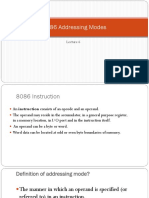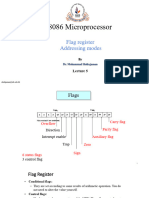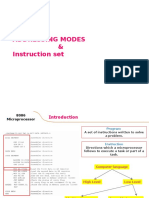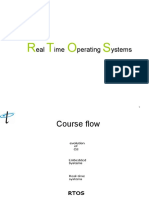0% found this document useful (0 votes)
66 views33 pagesLecture (6) - Addressing Modes
The document covers the Intel 8086 microprocessor, detailing its architecture, registers, memory management, and assembly program structure. It explains various instruction types, particularly the MOV instruction, and different addressing modes such as register, immediate, direct, and indirect addressing. Additionally, it discusses the processor modes including Real-Address mode, Protected mode, and Virtual 8086 mode.
Uploaded by
adelashrafengCopyright
© © All Rights Reserved
We take content rights seriously. If you suspect this is your content, claim it here.
Available Formats
Download as PDF, TXT or read online on Scribd
0% found this document useful (0 votes)
66 views33 pagesLecture (6) - Addressing Modes
The document covers the Intel 8086 microprocessor, detailing its architecture, registers, memory management, and assembly program structure. It explains various instruction types, particularly the MOV instruction, and different addressing modes such as register, immediate, direct, and indirect addressing. Additionally, it discusses the processor modes including Real-Address mode, Protected mode, and Virtual 8086 mode.
Uploaded by
adelashrafengCopyright
© © All Rights Reserved
We take content rights seriously. If you suspect this is your content, claim it here.
Available Formats
Download as PDF, TXT or read online on Scribd
/ 33


























































































